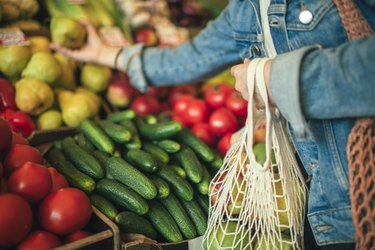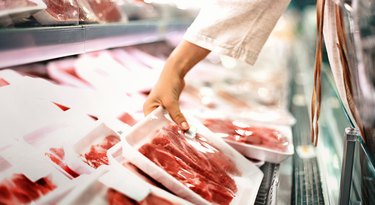
From the stock clerk in the grocery store to the delivery person transporting your takeout, your food meets a multitude of hands before it tops your plate. If one of those handlers is harboring the novel coronavirus, can the food become contaminated — and then infect you?
Here, Jagdish Khubchandani, PhD, MPH, an epidemiologist and associate chair and professor of health science at Ball State University, clears up the confusion around catching coronavirus from food and offers tips on how you can avoid actual foodborne illnesses that may impair your immune system.
Video of the Day
Video of the Day
Get tips on how to stay healthy, safe and sane during the novel coronavirus pandemic.
Though there's still much to learn about the novel coronavirus, scientists and medical professionals seem to be in consensus about one thing: Catching COVID-19 from food is highly unlikely.
In fact, to date, there is zero evidence to support the idea that the virus spreads through food, according to the Centers for Disease Control and Prevention (CDC), the USDA and the World Health Organization (WHO).
Based on what we know about viruses like the one that causes COVID-19, they replicate in the respiratory tract, not the GI tract, as explained in a February 2018 overview in Current Opinion in Virology. This type of transmission — through a respiratory route — is unlike foodborne illnesses, which infect you when you eat or drink something polluted with pathogens (more on this later).
Related Reading
The highly contagious coronavirus circulates from person to person predominantly via tiny respiratory droplets expelled when an infected person coughs, sneezes or speaks, Khubchandani tells LIVESTRONG.com. These infectious droplets then find their way into the mouths or noses of those nearby, who may also breathe them into their lungs, per the CDC.
But you don't have to be showing symptoms to spread the infection, Khubchandani explains. In fact, 40 percent of people with SARS-CoV-2, the virus that causes COVID-19, never show symptoms of the illness, per the CDC.
That means just being in close quarters with (aka less than six feet away from) an infected individual can put you at risk.
Even if they're not coughing or sneezing, sick people can transmit the virus simply through breathing or talking, which becomes even more problematic when you take into account that it can live in the air for a few hours, Khubchandani says.
Do You Need to Be Careful With Food Packaging?
Just as you're unlikely to catch the coronavirus from eating, it's also unlikely that you'll pick up the pathogen from touching a milk carton, canned goods or plastic packaging, per the CDC.
Yes, it is possible that you may come into contact with a soiled surface or object and then touch your own mouth, nose or eyes. "This is not thought to be the main way the virus spreads," according to the CDC. In fact, no cases of COVID-19 have been traced to touching food or its packaging, per the CDC.
Early on during the pandemic — when less was known about the transmission of the virus — many people adopted the habit of wiping down food packaging and containers with disinfectant. You can wipe packaging as an "extra precaution," according to the U.S. Food and Drug Administration. But it's not an essential task.
Warning
Do not use bleach or ammonia, which are designed for hard surfaces, on cardboard or food in plastic wrap, according to the CDC.
A bigger priority than scrubbing packaging? Cleaning your hands. Wash your hands with soap and water for at least 20 seconds, when you get back home from the grocery store and again after handling food, per the CDC.
What You Need to Know About Foodborne Illnesses

Unlike COVID-19, foodborne viral infections like hepatitis A and the norovirus spread by eating or drinking contaminated food and water, per the FDA.
While viruses can be the source of foodborne illnesses, "among infectious disease agents, the top causes are mostly bacterial: Campylobacter, Salmonella, Clostridium and Staphylococcus," Khubchandani says.
Leaving food out at room temperature for too long can encourage the growth of these dangerous bacteria. Indeed, these perilous pathogens produce most rapidly between 40 and 140 degrees Fahrenheit, a range of temperatures coined the "Danger Zone," per the USDA. In the danger zone, the number of bad-for-you bacteria can increase twofold in just 20 minutes.
Though the American food supply is by-and-large safe, "unfortunately, these disease agents are still present in a wide variety of food items," Khubchandani says.
The foods most likely to be contaminated include raw or undercooked meat, poultry, eggs, shellfish and unpasteurized milk, according to the CDC. Fruits and veggies are also vulnerable to disease-causing germs.
And once you've consumed something contaminated, these malevolent microbes may make you sick with symptoms ranging from mild GI discomfort to serious life-threatening illness. For the most part, foodborne illnesses make you weak and dehydrated and, as a result, temporarily diminish the body's natural defenses, Khubchandani says.
And though, traditionally, sick people don't pass foodborne pathogens on to others, infected individuals can contaminate foods, according to Khubchandani.
Additionally, there's some evidence that foodborne illnesses may transmit directly from person to person through feces and water, though additional research is needed, he says.
Related Reading
How You Can Avoid Foodborne Illness
While dealing with a foodborne infection is never fun, now more than ever — as we contend with the COVID-19 pandemic — we should be taking steps to steer clear of anything that may impede our immune systems and increase our risk of getting sick.
These four simple safety strategies from the CDC will help you dodge diseases caused by foodborne germs:
1. Wash Your Hands, Counters and Produce
Wash your hands before and after preparing food, scrub kitchen surfaces often (like cutting boards and countertops) and clean utensils that came into contact with raw foods before reusing them.
For fresh fruits and veggies, rinse thoroughly under running water — you can skip soap or produce wash, per the CDC.
2. Separate
To avoid cross-contamination between foods, separate them. Keep raw meat, poultry, seafood and eggs away from other foods in your cart while grocery shopping and in your fridge at home. Use different utensils, cutting boards and plates for raw meat, poultry and seafood.
3. Cook to the Right Temperature
Use a thermometer to cook foods to a safe internal temperature hot enough to kill disease-causing germs: 160°F for ground meats, 165°F for poultry and 145°F for fish.
4. Chill
Refrigerate perishable food within two hours at 40°F or below (if it's warm outside, food shouldn't be away from the fridge for more than an hour).
When thawing frozen foods, defrost in the fridge, microwave or in cold water. Never thaw foods on the counter at room temperature (i.e. the danger zone) because bacteria will multiply quickly in this environment.
Concerned About COVID-19?
Read more stories to help you navigate the novel coronavirus pandemic:
- Current Opinion in Virology: “Transmission routes of respiratory viruses among humans.”
- FDA: What You Need to Know about Foodborne Illnesses
- USDA: "’Danger Zone’ (40 °F - 140 °F).”
- Centers for Disease Control and Prevention: “Foods That Can Cause Food Poisoning.”
- Centers for Disease Control and Prevention: “Four Steps to Food Safety: Clean, Separate, Cook, Chill”
- Centers for Disease Control and Prevention: “How COVID-19 Spreads.”
- USDA: “Coronavirus Disease (COVID-19).”
- World Health Organization: “Q&A on coronaviruses (COVID-19).”
- CDC: "COVID-19 Pandemic Planning Scenarios"
- CDC: "Food and Coronavirus Disease 2019 (COVID-19)"
- U.S. Food and Drug Administration: "Shopping for Food During the COVID-19 Pandemic - Information for Consumers"
- CDC: "Fruit and Vegetable Safety"
Is this an emergency? If you are experiencing serious medical symptoms, please see the National Library of Medicine’s list of signs you need emergency medical attention or call 911.